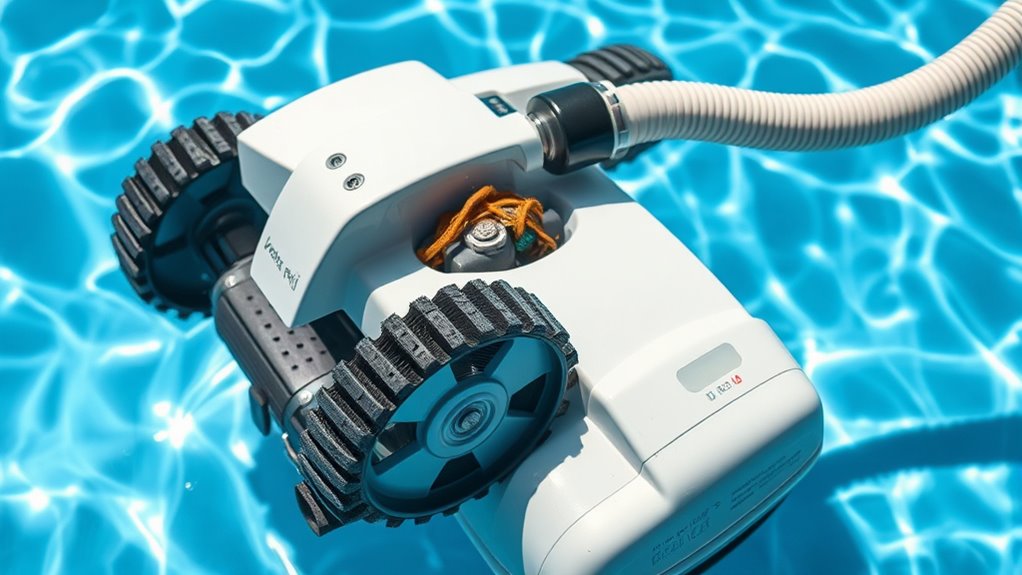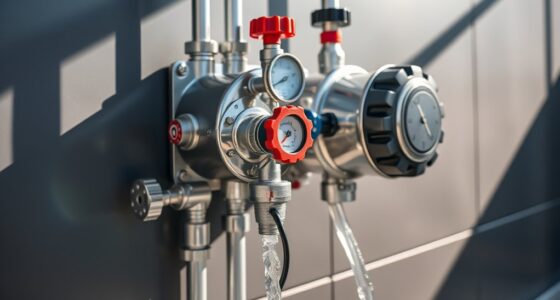If your automatic pool cleaner isn’t cleaning effectively, keeps breaking down, or shows signs of physical damage, it’s time to evaluate replacing it. Worn parts, tangled cords, or declining battery life also signal that your device has reached the end of its lifespan. Outdated models lacking modern features or safety standards may require an upgrade. Staying aware of these signs helps keep your pool clean and safe—learn more about when it’s best to switch.
Key Takeaways
- Declining cleaning performance or frequent mechanical failures indicate it’s time for a replacement.
- Visible damage, cracks, or worn parts signal the cleaner’s end of lifespan.
- Significantly reduced battery life or power issues suggest outdated technology needs upgrading.
- Persistent debris buildup or water quality problems despite maintenance point to inefficiency.
- Rising repair costs outweigh the price of a new unit, making replacement more economical.
Decline in Cleaning Performance
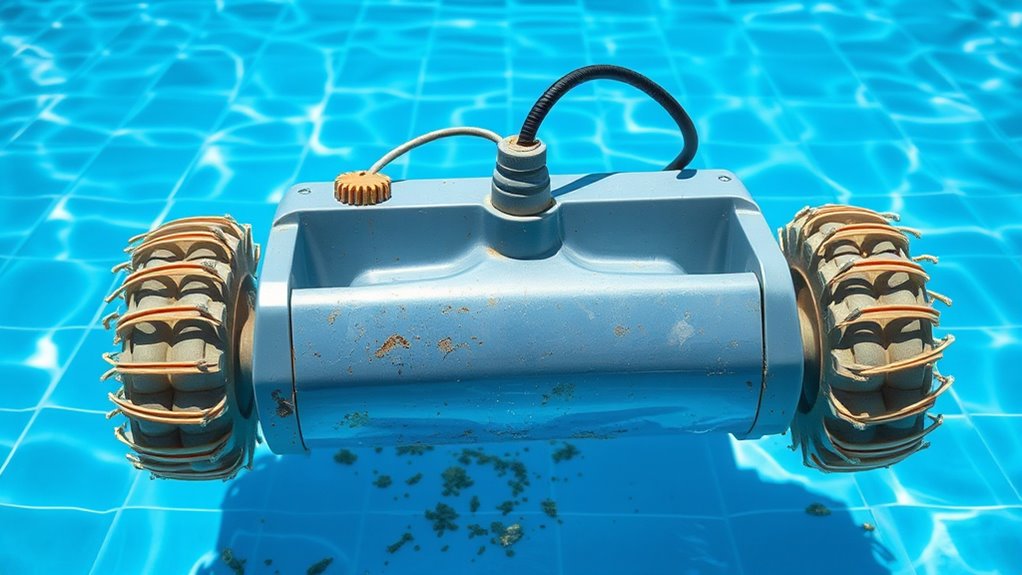
Over time, you may notice that your pool cleaner isn’t picking up debris as effectively as it used to. This decline in cleaning performance often signals that something’s off. One common cause is imbalanced pool chemical levels, which can affect the cleaner’s ability to grip surfaces and pick up dirt. Make certain to regularly check and maintain proper chemical balance, as poor water quality hampers cleaning efficiency. Additionally, consult your user manual for updates; manufacturers sometimes release new guidelines or troubleshooting tips that can improve performance. If adjusting chemical levels and following updated instructions don’t restore cleaning power, it might be time to consider replacing your cleaner. Regularly inspecting the filter and brushes can also help identify wear and tear early, preventing further decline in cleaning effectiveness. Staying informed about product lifespan and typical wear patterns can guide you in timely replacements for optimal performance. Being aware of effective maintenance practices can further extend the life of your pool cleaner and keep it operating at peak efficiency. Performing routine cleanings and checks can help detect early signs of issues before they significantly impact performance.
Frequent Mechanical Failures
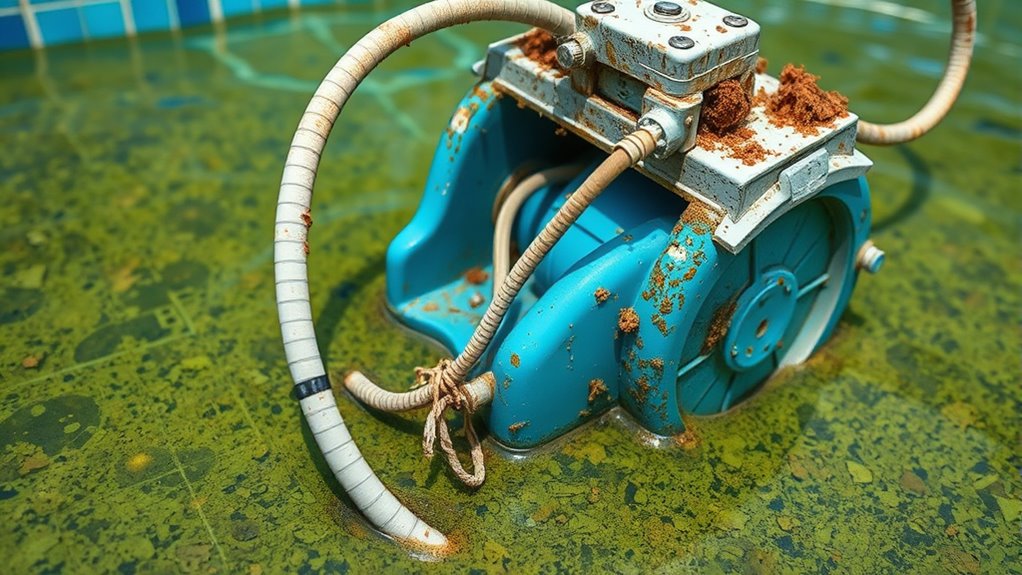
If your pool cleaner keeps breaking down or shows signs of persistent malfunction, it’s a clear warning. Recurrent mechanical failures can waste your time and money, making repairs less practical. When these issues become frequent, it’s probably time to contemplate replacing the unit. Consider the overall Kia Tuning potential for upgrades and repairs, which can also apply to maintaining your pool cleaner’s functionality. Additionally, assessing the durability of your current model can help determine whether a replacement might offer better long-term value. Regular maintenance and understanding the benefits of consistent upkeep can prolong your device’s lifespan and improve performance over time. Recognizing when a powerful motor begins to underperform is crucial, as it often indicates that repair costs may outweigh the benefits of continued use. Moreover, evaluating the contrast ratio can help you decide if your cleaner’s performance is diminishing in low-light conditions, signaling it may be time for an upgrade.
Recurrent Mechanical Breakdowns
Frequent mechanical failures are a clear sign that your pool cleaner is nearing the end of its lifespan. When breakdowns happen repeatedly, it can be frustrating and costly. Often, issues stem from improper pool chemical balance, which can corrode parts or cause the cleaner to work harder than it should. Before replacing your cleaner, review the user manual troubleshooting section—sometimes, simple adjustments or cleaning can resolve recurring problems. Additionally, preventive maintenance can help identify potential issues early and extend the life of your equipment. Proper routine inspections can also catch wear and tear before major failures occur. Regular inspection of components can reveal signs of deterioration that may lead to breakdowns. If breakdowns persist despite proper chemical levels and troubleshooting, it indicates the parts are worn out or damaged beyond repair. Continuing to repair a frequently malfunctioning cleaner may not be cost-effective or efficient. At this point, replacing your pool cleaner is likely the best choice to ensure reliable operation and maintain your pool’s cleanliness. Additionally, monitoring equipment maintenance can help prevent future failures and extend the lifespan of your pool cleaner. Being aware of regional environmental factors can also influence the longevity of your equipment.
Persistent Malfunction Signs
Persistent malfunction signs, such as recurring mechanical failures, clearly indicate your pool cleaner is no longer operating efficiently. If these issues happen frequently, it’s time to contemplate replacement, especially when timing considerations suggest repairs become more costly than a new unit. Environmental impacts, like mineral buildup or debris, can accelerate wear and tear, leading to persistent malfunctions. Ignoring these signs can result in poor cleaning performance and increased energy use. Regularly assess your cleaner’s functionality, noting whether frequent breakdowns persist despite troubleshooting. If repairs are becoming a routine, replacing your cleaner is more practical and cost-effective. Understanding pool cleaner lifespan and the importance of timely replacement can also influence the longevity of your pool equipment. For example, Hyundai vehicles with performance upgrades often experience extended durability, which can be analogous to the longevity of pool equipment when properly maintained. Being aware of equipment durability can help you plan for replacements proactively. Additionally, considering jet boat technology advancements can inform how modern pool cleaners are designed for longer service life. Don’t delay replacement when these malfunction signs persist; it ensures your pool stays clean and saves you money in the long run.
Excessive Repair Costs
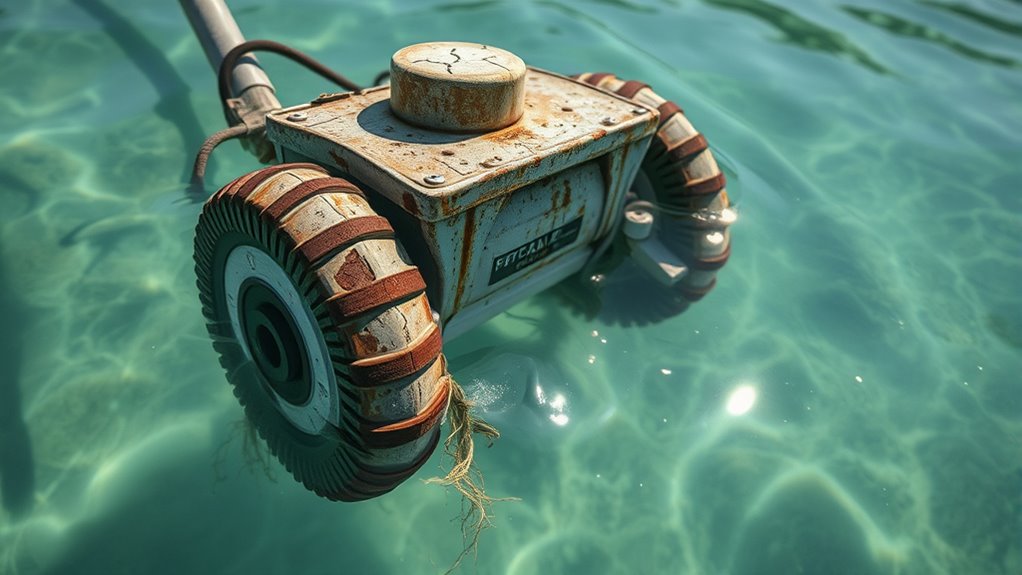
When repair costs for your pool cleaner start to climb considerably, it’s a clear sign that investing more money might not be worthwhile. Frequent repairs can indicate underlying issues, especially if you’ve been diligent with user maintenance and maintaining proper pool chemistry. If repairs exceed the cost of a new cleaner, it’s time to contemplate replacement. High expenses often mean parts are worn out or inefficient, leading to ongoing expenses. To assess the overall situation, consider this:
| Repair Cost | Condition |
|---|---|
| High | Frequent, expensive repairs; old unit |
| Moderate | Occasional repairs; some wear but manageable |
| Low | Minor fixes; unit still economical to repair |
Balancing repair costs against new investment ensures your pool stays efficient without draining your budget.
Persistent Tangling or Jamming
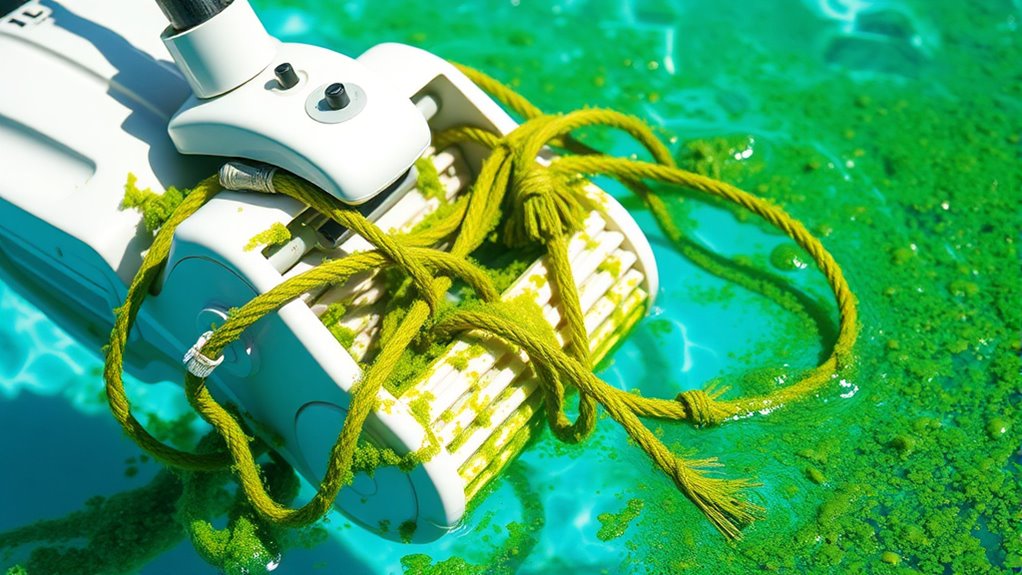
If your pool cleaner consistently gets tangled or jammed during operation, it’s a clear sign that replacement might be necessary. Frequent tangling can indicate worn or damaged brushes, tangled cords, or an ineffective design that hampers performance. Before replacing it, try manual cleaning to remove debris that may cause jams. Additionally, ensure your pool’s chemical balancing is correct; unbalanced chemicals can create surface film or algae, which can contribute to clogs or tangles. If these adjustments don’t improve the cleaner’s performance, persistent jamming suggests the unit’s internal parts are too worn or incompatible with your pool’s conditions. In such cases, investing in a new cleaner will save you time and prevent ongoing frustration. Recognizing when to replace ensures your pool stays clean with minimal hassle.
Battery or Power Issues
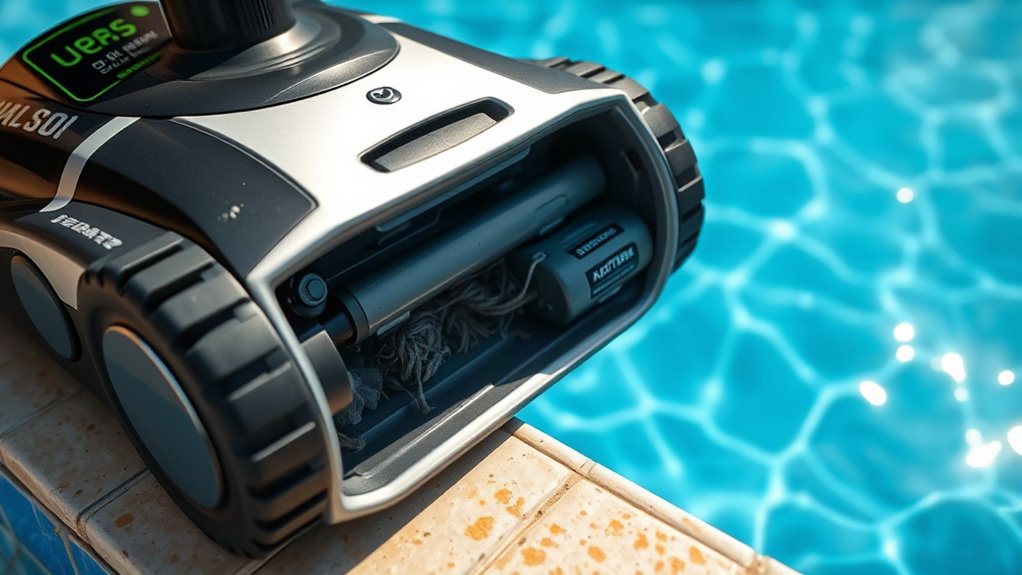
Power issues are a common sign that it’s time to replace your pool cleaner. If your device’s battery life has drastically decreased or it struggles to hold a charge, it’s a clear indicator that the battery no longer performs reliably. Similarly, if your cleaner relies on a power source and you notice inconsistent or weak power delivery, it may be time for a replacement. Over time, batteries deteriorate, and power sources can develop faults that compromise performance. Persistent power problems lead to inefficient cleaning and frustration. Replacing your pool cleaner ensures you maintain effective operation without frequent repairs. Don’t wait until it completely stops working—addressing battery or power source issues early saves you time and money in the long run.
Outdated Technology
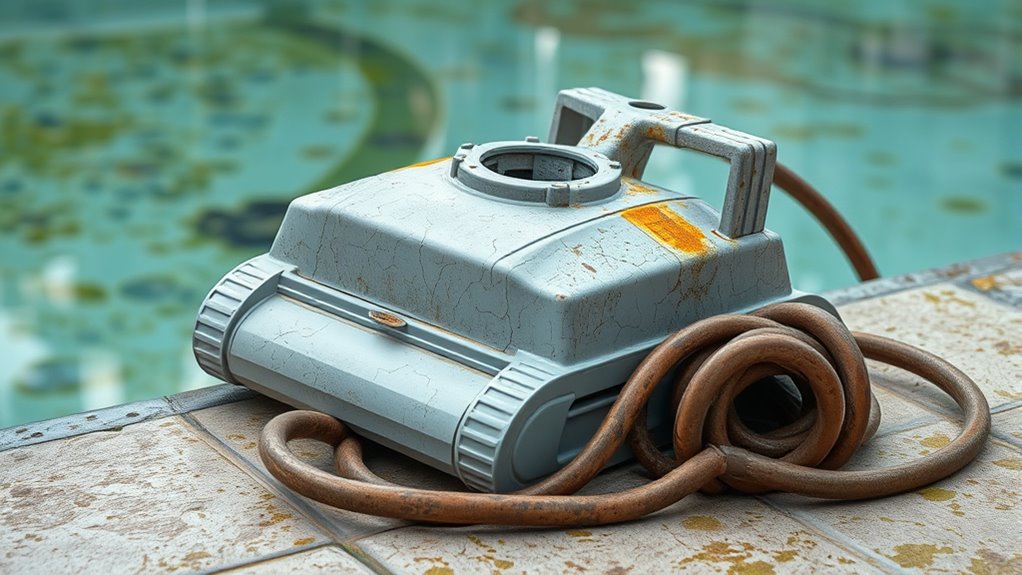
Outdated technology can hinder your pool cleaner’s performance, making it less effective at maintaining a pristine pool. Older models often lack modern features like remote control operation, which allows you to start or stop cleaning sessions conveniently. Additionally, outdated cleaners may not have programmable features, limiting your ability to customize cleaning schedules or set specific routines. Without these advancements, you might find yourself manually guiding the cleaner or dealing with inefficient cleaning cycles. Over time, the lack of technological upgrades can lead to missed spots and increased maintenance needs. If your pool cleaner relies on outdated technology, it’s a sign that it’s time to think about a replacement. Upgrading ensures you benefit from smarter, more efficient cleaning with minimal effort.
Physical Damage or Wear
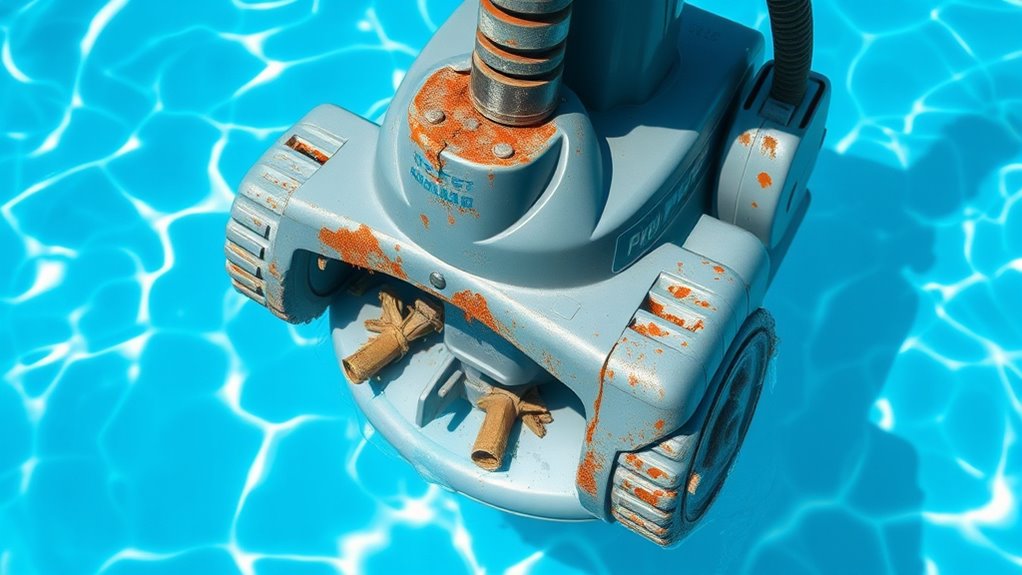
If you notice cracks, fractures, or worn-out parts like brushes or gears, your cleaner isn’t working efficiently anymore. Damaged power cords can also hinder its performance or pose safety risks. When these issues appear, it’s time to contemplate replacing your pool cleaner.
Cracks or Fractures
Cracks or fractures in your pool cleaner are clear signs that it’s time to contemplate replacing or repairing it. Over time, material fatigue weakens the plastic or rubber components, making them more prone to splitting. These fractures can compromise the cleaner’s structural integrity, reducing its effectiveness and lifespan. While minor aesthetic damage might not affect performance, cracks signal deeper issues that could lead to leaks or complete failure. Inspect your cleaner regularly for visible damage, especially after rough handling or exposure to chemicals. If cracks or fractures are present, consider replacing the unit or seeking professional repairs to prevent further damage and ensure your pool stays clean and well-maintained. Ignoring these signs can result in costly repairs or the need for a full replacement.
Worn-out Brushes or Gears
Worn-out brushes or gears are clear indicators that your pool cleaner needs attention. If you notice decreased cleaning efficiency, it’s time for brush replacement or gear maintenance. Here are signs to watch for:
- Bristles worn flat or missing, reducing scrubbing power.
- Gear clicking or grinding noises during operation.
- The cleaner dragging or missing spots on the pool floor.
- Visibly cracked or broken gears or brushes.
Address these issues promptly to avoid further damage. Replacing brushes and maintaining gears can restore your cleaner’s performance. Regularly inspect the brushes for wear and replace them when necessary. Likewise, check gears for cracks or signs of fatigue. Proper brush replacement and gear maintenance help extend your cleaner’s lifespan and keep your pool sparkling.
Damaged Power Cords
Over time, physical damage or wear can compromise your pool cleaner’s power cord, leading to operational issues. Frayed insulation, exposed wires, or cracks increase the risk of electrical safety hazards and can cause the cleaner to malfunction. If you notice any visible damage, it’s time for a power cord replacement to guarantee safe operation. Continuing to use a damaged cord can pose serious safety risks, including electric shock or short circuits. Regularly inspecting the cord helps catch early signs of wear before more extensive damage occurs. Replacing a worn or damaged power cord not only restores peak performance but also safeguards your safety. Don’t ignore signs of damage—prioritize power cord replacement to keep your pool cleaner running smoothly and safely.
Changes in Pool Conditions
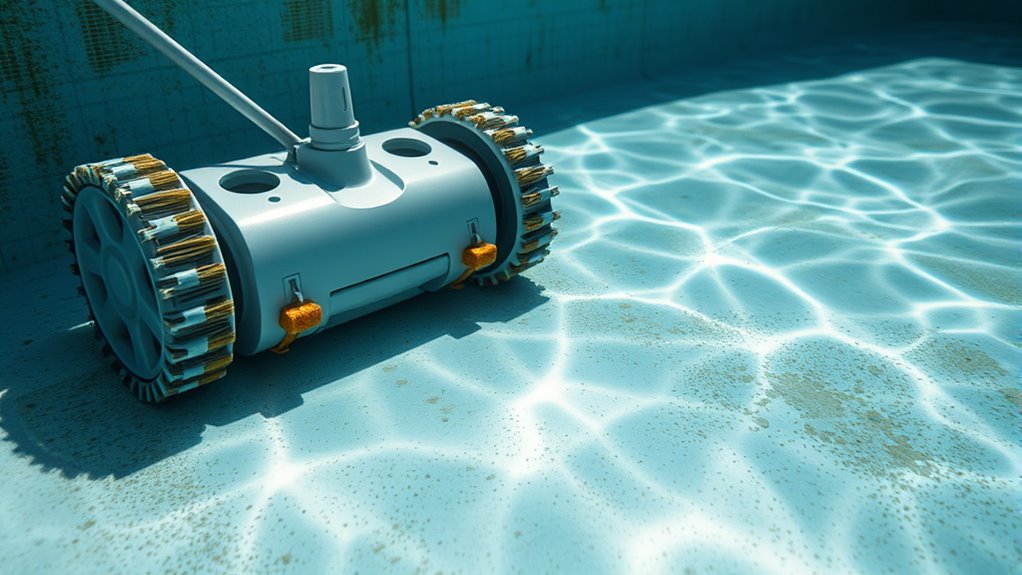
Changes in your pool’s conditions can signal that it’s time to replace your cleaner. If you notice consistent issues despite adjusting your operator maintenance routines, consider these signs:
- Unusual debris or algae buildup, indicating the cleaner isn’t effectively managing pool water chemistry.
- Persistent cloudiness or discoloration, suggesting the cleaner isn’t circulating or filtering properly.
- Frequent breakdowns or malfunctions, which can stem from wear and tear due to fluctuating conditions.
- Increased energy use or noise, often caused by strain on the cleaner’s components from changing water conditions. Monitoring these signs helps you decide if your automatic pool cleaner needs replacing to maintain ideal pool health and performance.
Safety Concerns and Compliance

When considering whether to replace your pool cleaner, safety concerns and compliance can’t be overlooked. A malfunctioning or outdated cleaner may pose risks to pool safety, such as electrical hazards or debris that gets trapped, creating potential injuries. Confirming your cleaner meets compliance regulations is essential to avoid fines and ensure safe operation. Older models might lack necessary safety features or fail to adhere to updated standards. Regular inspections help identify worn parts or damage that could compromise safety. If your cleaner shows signs of electrical issues, leaks, or excessive wear, it’s time to replace it. Prioritizing safety and compliance keeps your pool environment secure for everyone, preventing accidents and ensuring your equipment adheres to current safety standards.
Frequently Asked Questions
How Long Should an Automatic Pool Cleaner Typically Last?
Your automatic pool cleaner typically lasts between 3 to 5 years, depending on usage and maintenance. The pool cleaner lifespan varies, but you should start considering a replacement timeline when it becomes less effective, struggles to clean properly, or shows signs of wear and tear. Regularly check for damaged parts and clean it thoroughly. When repairs cost more than a new one, it’s time for a replacement.
Are There Eco-Friendly or Energy-Efficient Options Available?
You’re wondering if eco-friendly or energy-efficient options exist. Yes, solar-powered pool cleaners are available, harnessing sunlight to operate efficiently and cut energy use. Additionally, using biodegradable cleaning agents can make maintenance more eco-conscious. These options help reduce your environmental impact while keeping your pool clean. By choosing solar-powered devices and eco-friendly products, you can enjoy a greener pool experience without sacrificing performance or convenience.
Can Regular Maintenance Extend My Pool Cleaner’s Lifespan?
Imagine your pool cleaner working flawlessly, gliding smoothly as you maintain perfect pool chemical balance. Regularly checking the skimmer basket and cleaning filters prevents debris buildup that can strain the motor. With diligent maintenance, you extend your cleaner’s lifespan, avoiding sudden breakdowns. Keep an eye on signs of wear, and your automatic pool cleaner will keep performing efficiently, letting you enjoy crystal-clear water without interruption.
What Are Signs That a New Model Offers Better Cleaning?
You’ll notice that a new model offers better cleaning when your current cleaner’s performance declines, despite regular maintenance. Signs include incomplete debris removal, poor navigation, or frequent malfunctions. Model upgrades often feature advanced brushes, smarter navigation, and stronger suction, considerably enhancing cleaning performance. If your cleaner struggles to keep your pool spotless, it’s time to think about an upgrade for more efficient, reliable results and a cleaner, clearer pool.
Is It Worth Upgrading to a Robotic Pool Cleaner?
Upgrading to a robotic pool cleaner can be worth it if you’re concerned about safety and want reliable performance. Newer models often have advanced features, better brand reputation, and improved cleaning efficiency. If your current cleaner struggles or raises safety concerns, investing in a modern robotic cleaner makes sense. It saves you time, enhances safety, and guarantees your pool stays pristine. Consider these factors to decide if now’s the right time to upgrade.
Conclusion
When your automatic pool cleaner starts underperforming or breaking down more often, it’s time to think about replacing it. Don’t ignore signs like persistent tangling, costly repairs, or safety concerns. Remember, a stitch in time saves nine—address issues early before they become bigger problems. Upgrading your cleaner ensures your pool stays sparkling and hassle-free. Trust your instincts and don’t wait until it’s too late; a new cleaner can make all the difference.

